#SharePoint Migration Tips
Link
#sharepoint planning#SharePoint Migration#SharePoint Migration Tips#Sharepoint Development#reality tech
0 notes
Text
Customers' private payments, permissions, preferences, and facts are easily transferred from one SharePoint environment to another during the essential procedure of migrating SharePoint SharePoint users. The primary intention in no way adjustments, whether or not you are updating to an extra current version of SharePoint or shifting from on-premises SharePoint to SharePoint Online, is to allow customers to continue running on their projects uninterrupted. Successful migration of SharePoint purchasers depends on keeping the crucial elements that encompass user proper access, permissions, and custom-designed settings, all while mitigating potential outages and the risk of fat loss.
#sharepoint migration 2010 to 2016#sharepoint migration framework#sharepoint migration tool#sharepoint online migration#sharepoint user migration#what is sharepoint migration
0 notes
Link
👨💻 SharePoint Migration Best Practices: Tips From A SharePoint Consultant 👨💻
Migrating to SharePoint can be a challenging process, especially if you are moving from a legacy system or a different platform. However, with the right planning and preparation, a SharePoint migration can be a smooth and successful process.
In this article, we will provide best practices and tips for a successful SharePoint migration, based on the experience of a SharePoint consultant.
Read More 🌐 - https://bit.ly/409gUhy
#sharepoint#microsoft#office#digitaltransformation#intranet#software#powerbi#technology#cloud#microsoftteams#powerapps#datascience#onedrive#collaborationsoftware#sharepointonline#business#chatbots#microsoftsharepoint#msteams#techasoft#sharepointintranet
0 notes
Text
TIPS ON HOW TO CHOOSE THE BEST PPM TOOL FOR YOUR COMPANY
The world is evolving so fast as well as technology; your company need to cope up with these high demands to be able to stay in business. You need to meet all project’s requirements in delivering best quality services in timely manner. Having the best Project Portfolio Management Tool for your Company will help you accomplish these goals. By the way, if you will ask what is a PPM tool, it is a centralized management system to oversee the Project Portfolio Management process. While Project Portfolio Management or PPM is defined by Wikipidea as “a senior leadership discipline that drives strategic execution and maximizes business value delivery through the selection, optimization, and oversight of project investments which align to business goals and strategies”. Once you decided to get this tool for your company; the question now is how you can determine the best PPM tool suited for your organization. That’s why we are more than happy to give you tips on how to choose the best PPM tool for your company or team.
To find the right PPM tool or software you must consider two key factors: first, if it is fit for your organization’s need and secondly is the cost. Considering these factors, we would like you to check Project Online. Regarding the first factor, you need to determine how this PPM tool can meet the specific needs of your company. The good news in Project Online is that we designed Simply PMO to give you a Project Management solution tailored to fit your company needs! To give you brief background, Project Online is a flexible online solution for PPM. Delivered through Office 365, Project Online provides powerful project management capabilities for planning, prioritizing, managing projects and project portfolio investments from almost anywhere on almost any device.

Regarding the second factor which is cost, always put in mind if the value that this PPM tool provides will compensate the cost. Now have a look what are included in the Project Online Office 365 services:
SharePoint Online: Quick Start Package, Managed Services, Migration from on prem to O365, Flow, Power Apps

Project Online: Quick Start Package, Custom Project Stage Tracker, Migration from on prem to O365, Flow, Power Apps
Office 365: Teams, Flow, Power Apps, Share Point, Project
Managed Services: Access to Experts, Fast and Easy Onboarding, Maximize Return on Investment
Migration Services: Migrate to SharePoint Online, Migrate to Project Online, Free Migration to Exchange Online
Does Project Online qualified for the key determining criterias for considering the best PPM tool? The choice is yours!
1 note
·
View note
Text
What is SharePoint Migration?
SharePoint Migration is mind boggling and diverse exercises with a wide range of weak spots.
With cautious and exhaustive preparation and readiness, your current or inheritance SharePoint climate can be changed when you relocate into your new climate, assisting you with completely understanding the worth of your SharePoint speculation.
Beyond Intranet's group has a sound comprehension of SharePoint object model 2013 and data set diagram that assists us with removing information and relocate you to the most recent rendition of SharePoint.
We can deal with SharePoint Migration Administrations can drives of any size, from both an "all out client base" point of view as well as a "content data set and measuring" viewpoint. Our SharePoint specialists will abridge the gamble, time and exertion expected to combine, move and revamp content.
We attempt to battle the essential methodology towards SharePoint of it being a specialized stage; we comprehend that it is a profoundly powerful business stage that backings and fills in as an impetus for proficient work process.
That is the reason our group reconsiders your association's SharePoint climate to guarantee its specialized effectiveness and that your association gets the greatest advantage of SharePoint Migration.
SharePoint Specialists do SharePoint Online Migration as indicated by the Accompanying Advances:
Appraisal of the current SharePoint climate to investigate SharePoint's engineering, our SharePoint Migration administrations gives best review of SharePoint locales and characterize the specific Migration model. Examining current SharePoint site and SharePoint and arrangements, including site assortments, what are destinations? Destinations alluded as far as their motivations and construction, authorization the executive’s model, intricacy of site customization and some more.
Reviewing the substance across each SharePoint arrangement, to characterize the basic site content that is given as number-one need while doing SharePoint moving, or the one that is obsolete, massive or disagreeable.
Illustrating a concise SharePoint Migration plan with exact SharePoint Migration exercises and their succession.
The Migration in accordance with plan. As a piece of this SharePoint Migration stage, we additionally reset SharePoint work processes, revamp and improve content, rebuild locales and site assortments, fix or recode for best customizations, Beyond Intranet gives custom SharePoint marking and that's only the tip of the iceberg.
Next is to trial of the new SharePoint climate to control practical equivalency, site execution and site security issues.
SharePoint Counseling help is to direct SharePoint heads to layout the administration prerequisites that applicable to another SharePoint sending, and SharePoint instructional meetings and SharePoint support accommodated the end-clients.
Post-SharePoint Migration administration and backing to help the association in fixing specialized issues to stay away from and to beat client reception blunders and traps.
SharePoint Migration Administrations for Business Coherence:
Beyond Intranet is notable for best SharePoint rehearses, our SharePoint specialists sees their central goal in focusing on the business uprightness process, SharePoint Migration administrations group is to lessen the SharePoint Migration dangers to develop a wonderful workplace. For the SharePoint Migration, we set our earnest attempts on.
Explaining a SharePoint server migration plan and Continuous working cycles
Moving basic site content in the base time periods without upsetting the business processes.
Keeping the webpage content safe and SharePoint online migration arrangements.
Conveying new elements
Conveying new elements that will assist association with taking care of business process with lesser endeavors.
Advancing SharePoint arrangement engineering and limiting the upkeep and backing expenses of the business tasks.
Fortifying client SharePoint reception
Get to know the SharePoint Migration instrument constraints and its extensible elements. Microsoft's new SharePoint Migration device utilizes the Programming interface to rapidly transfer massive documents to Office 365 and limit how much time consumed and spent during your migration.
Highlights of SharePoint Content Migration:
Extensible Security Managing
Source SharePoint Content Pre-check
Top Migration Plans with customization
Gradual or full SharePoint Migration
Both SharePoint on the web Or Disconnected Migration
Information Synchronization With tweaked and booked Migration
Information misfortune anticipation
Get a total arrangement and manual for relocate SharePoint content and oversee utilizing a solitary best bound together stage. Guarantee smooth post- migration the board with itemized investigation, revealing and regulatory activities.
Our Team’s Profundity of Involvement Diminishes the Gamble and Season of SharePoint Arrangements. Our SharePoint Migration Drives are:
Distinguish Migration bottlenecks before they become an issue
Fix huge site assortments, obsolete locales or content, looked at records, and different dangers
Break down sway and foster Migration plan for custom web parts, website formats and work processes
Tidy up SharePoint by recognizing and eliminating unused locales, content, clients or gatherings.
Smooth out consents to further develop security and diminish hazard of information spills.
Quick and Adaptable Migration to SharePoint 2013 or Office 365 in a solitary bounce from SharePoint 2010, SharePoint 2007, or SharePoint 2003.
Sort out destinations, content and consents
Get in touch with us to talk about your SharePoint Migration needs.
0 notes
Text
10 Tips to Pass Microsoft Certification Exams and Earn MCSA Certification has been published at http://www.theleader.info/2018/10/30/10-tips-pass-microsoft-certification-exams-earn-mcsa-certification/
New Post has been published on http://www.theleader.info/2018/10/30/10-tips-pass-microsoft-certification-exams-earn-mcsa-certification/
10 Tips to Pass Microsoft Certification Exams and Earn MCSA Certification
Passing Microsoft MCSA should not be as hard as you think. With a proper preparation and execution of your plan, you should find it easy to succeed in this certificationtest. The Microsoft MCSA exam was created by Microsoft, so that you can certify your skills in managing Office 365 identities and requirements. The exam questions come from various sections, all of which need proper preparations from the students to excel. Your efforts in learning determine whether you will pass or fail. 10tips you can follow to prepare for Microsoft MCSA exam Tip 1: Have a grasp of the exam content PrepAway Exam content is updated from time to time.Study relevant materialsand be always aware of changes with regards to what is likely to be tested in the exam. If you prepare for the test using resources made 4 years ago, you will obtain knowledge about an outdated technology. You should focus on what is current and useful for the future. Some exam questions tend to project onto a future technology. Therefore, look at any future trendsduring your studying. Tip 2: Be comfortable with PowerShell Who can ignore the power of PowerShell when it comes to Microsoft MCSA? This is a hot area that the examiners like while testing their candidates for the certification exam. You should ensure that you have a proper understanding of how to connect to Azure AD, the steps involved in connecting to Office 365 through PowerShell, the requirements of a good password policy, anddifferent incidences, such as resetting any user’s cloud passwordand changing a UPN. You must get to know how commands differ and what each one is meant to do. Tip 3: Adding and configuring custom domains Be sure that you have a proper understanding of how to specify domain name and domain purpose, update and perform verification of domain settings, transfer the ownership of domain name service to Office 365, and also confirm the ownership of domain. Furthermore, you need to be good at planning a pilot. This entails the identification of workloads, which do not need migration, running IdFix, creating a test plan, performing connectivity checks, and also setting up email accounts. How good are you at configuring tenant region, tenant name, and initial global administrator? You need to have a grasp of these topics if you intend to excel in the Microsoft MCSA certification exam Click here to download Practice tests https://www.prepaway.biz Tip 4: Manage cloud identities Do you have enough skills to configure password management, security groups and managing user,and operate cloud identities using Windows PowerShell? You will need to understand these fields to have an upper hand in passing the exam. The management of cloud identities collectively captured various components, such as password complexity, setting expiration policy, Admin center password resets, using Admin center to perform soft delete, configuring multi-factor authentication, and performing bulk CSV import. In addition, you should also know how to configure passwords to never expire, update simultaneously all user profiles, delete users, and manage bulk user license. Tip 5: Networking and security As an IT professional, you are expected to have an understanding of the crucial roles played by security in any IT product. Office 365 is not an exception. If you get ready for the Microsoft MCSA exam, then you should put a considerable amount of your energy on planning and implementing networking and security in O365. Doing so will entail various items: enabling the connectivity to Office 365, configuring DNS records for services, administering Azure RMS, and managing administrator roles.It is important to notice that SharePoint Online, Skype for Business Online, and Exchange Online are significant facilitators of networking in the organization. As the networking facilities are set, you should understand how they are secured. Tip 6: Using Azure AD Connect If you have no knowledge on Azure AD Connect, you have very minimal chances of passing this exam. There is a requirement that you must have a grasp of setting up the Azure AD Connect tool, using Azure AD Connect to manage Active Directory users, and preparing on premises AD for Azure Active Directory Connect. To be more specific, candidates ought to plan support for various forests, plan for filtering AD, and clean up existing objects. In addition, you must be competent in the creation, deletion, and modification of users and groups via Azure AD Connect, as well as performing both scheduled and forced synchronization. Tip 7: Be knowledgeable on federated identities for SSO Microsoft MCSA seeks to make sure that the candidates have a grasp of installation and management of AD FS servers, WAO servers, and planning for AD FS. As a result, candidates for the exam get tested on Active Directory Federation Services (AD FS) internal topologies, WAP topologies, AD FS dependencies, multi-factor authentication, certificates, and planning namespaces. Besides, the creation of AD FS account, adding additional servers, and configuring standalone settings are also vital. Tip 8: Rights management The importance of this element in the Microsoft MCSA certification exam cannot be underestimated. You need to have an understanding of RMS sharing application, mobile clients, and the handling of RMS templates in Office 10/13/16. Aim at having not only theoretical concepts, but also the practical ability. Tip 9: Testing tools Technology changes at a faster rate. This means that tools get outdated frequently. When you prepare for the exam, checkout the tools that are outdated, the ones recommended for different situations, and the requirements for the tools currently in use. The tools that you should have in mind include: Connectivity Analyzer, TRIPP, IDFix, and Remote Connectivity Analyzer. Tip 10: Have a study plan As you use your own collection of resources for studying, make sure you have a plan how to learn from them. Without a plan, you will be possibly revolving around the same thing daily, eventually becoming unprepared for the test. To get more information about the test, follow the link: https://www.microsoft.com/en-us/learning/exam-MCSA.aspx Follow ten tips mentioned above and you will be on the right way to pass the Microsoft 70-370-46 exam.
1 note
·
View note
Text
Troubleshooting Office 365 Issues Made Simple
Do you often ask yourself the question – Is there an Office 365 problem today? or how to troubleshoot Office 365?
While you try to find the answer, your customers (end-users) complain because they can’t access their business applications. Apart from all this, your boss needs an immediate status update. Trust me. It doesn’t feel great to be in that situation. And we know it.
Despite Microsoft claiming to provide 99.9% SLA, issues will occur with the Office 365 applications such as Teams, Outlook, OneDrive, Exchange Online, SharePoint, Yammer, etc. Often, the issues aren’t even Microsoft’s problems but ISPs or internal network change. There can be a lot of reasons (Network, OS, browser, personal device, upgrade errors, Internet, and much more), but which one is it?
Welcome to the hybrid way of working, where you have limited visibility outside your IT perimeter.
In this article, we will help you understand how and why you should better manage IT issues using some of these O365 troubleshooting tips.
Keep reading…
8 Common and Known Issues with Office 365

As you already know, Office 365 is the go-to enterprise business productivity suite. According to Statista, over 1 Million companies worldwide are using the Office 365 suite. Believe it or not, 70% of those come from the US.
The following issues with Office 365 can arise when your remote end-users are working from home or office.
Cloud Availability Roadblocks
Performance Degradation
Login Access and Timeout
Synchronization Errors
Network Jitter
Bandwidth, Throughput, and Connection Problems
Packet Loss
Failed Program and Migration Update
As more employees connect to their favorite SaaS service directly through the Internet, you can expect to see more problems. (We hope not, though!) Hence, it’s critical to know if the Office 365 apps are performing well. The faster you identify and fix the situation, the sooner your employees return to a productive working digital experience.
The Office 365 Outage History
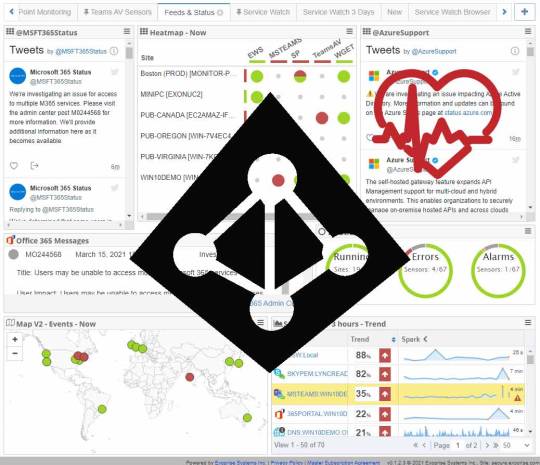
Furthermore, we are compiling a list of past O365 outages that you might be already aware of.
Microsoft Teams Outage on April 27
Azure DNS Outage on April 1
Microsoft 365 Outage on March 15
Exchange Online Mail Delivery Outage on February 3
Office 365 Outage on January 27
Teams Outage on August 19 (2020)
…
Phew, a long list, isn’t it?
Five significant outages this year to date. And you might think to yourself: Why are we telling you this?
That’s because, in all the above outages, we have successfully detected the problem 30 mins to 2 hours even before Microsoft acknowledged it on Twitter. When unseen and unplanned events like an outage occur, they bring new or compound ongoing IT investigations. As a result, end-users experience poor outcomes, and businesses suffer downtime losses. But, of course, I am assuming that you want to detect your next outage before it’s too late!
Learn more on how we handle outages on our Automated Outage Detection page.
5 Steps You Can Take to Successfully Troubleshoot Office 365 Outages & Slowdown Issues
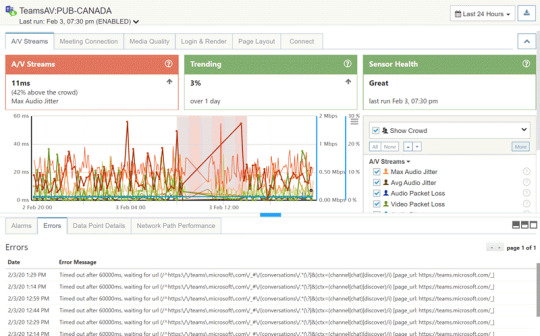
However, don’t let the thinking of an outage stop you. In spite of all the hurdles and rising flames in IT’s Kitchen, there is hope.
Below are troubleshooting steps that you must take to douse the fire.
1. Build Situational Awareness and Confidence with Proactive Notifications
No matter what monitoring tool you own, the responsibility to identify and resolve Office 365 performance issues rests on your shoulders. But let’s be honest. Would you want your customers or employees to reach out to you first or the other way? In other words, the days of being reactive are over; it’s the dawn of staying proactive and building some energy in the team.
Whether the issues lie with the provider (Microsoft), the LAN, or end-user computing environment, make sure your modern tool discovers them before customers reach out to you.
Consequently, your team comes across as more intelligent as they know what they are doing.
2. Baseline Office 365 Application Performance Data
Ok, you’ve got the awareness. But is there a way to baseline your Office 365 app performance? So first, let’s get to that. Did you know that our enterprise customers (BCD Travel, Robert Half, Aetna, Intel, etc.) pride themselves on crowd-sourced data?
Why? Our unique crowd-sourced analytics expedite root cause analysis by comparing your network infrastructure performance data to the rest. Indeed, this leads to quickly discovering and resolving problems – internal or external – within your IT environment. More importantly, your team reduces the response time and successfully meets their performance goals.
Congratulations, you can now answer, “Does the Office 365 fault lie with us or with everyone?”
Start a Free Trial Today. Its Simple To Get Started
Every day customers start and deploy a full suite of sensors in under 5 minutes. Give it a try for network benchmarks, root cause analysis and complete visibility into ALL of Office 365.
FREE TRIAL
3. Gain Actionable Intelligence with Synthetics
In a recent survey done by us, 70% of our customer issues were found in the corporate enterprise network and not with the provider. This is the truth about monitoring with synthetics.
Personally, it would help if you had that visibility so that your team isn’t wasting their precious time blaming Microsoft. Instead, network admins can use real-time insights from synthetic monitoring agents to test ALL of the Office 365 apps actively. Most likely, the chances are that you can find potential bottlenecks (proxy, gateway, router, DNS, LAN/WAN settings) in your backyard with a hop-by-hop network path visualization.
And you can take rapid action.
4. Package Real User Monitoring Insights with Digital Experience Monitoring
Undoubtedly, including synthetics as part of your monitoring strategy is supercritical. However, that’s just one side of the monitoring spectrum for your team to be efficient.
And let’s be honest.
Although synthetics can reveal if an Office 365 service is available or not, it cannot tell about the end-user experience for that particular application. Additionally, remote employees have multiple Desktop and network applications installed on their laptops. Take, for example, Microsoft Outlook. Even though Outlook may be up, it may be performing slow or crashing. Therefore, your team needs real user monitoring (RUM) insights to successfully capture endpoint data (CPU, memory, disk, crashes) to assist knowledge workers better.
A Digital Experience Monitoring solution combines the best of Synthetics and RUM in a single pane of glass. And in our experience, you need both – Better Together.
5. Manage Office 365 Outages in ServiceNow
Apart from discussing synthetics and RUM, let us talk about managing service alerts and automated notifications.
Do you own any of the below ITSM/AIOps/ChatOps/ITOM/DevOps tools in your environment?
ServiceNow
PagerDuty
MoogSoft
Slack
Splunk
ScienceLogic
ManageEngine
SumoLogic
If your answer is a yes, you can connect a Digital Experience Monitoring (DEM) tool to your favorite ticketing system and automate IT process workflows. By integrating 3rd party webhooks and APIs, your team can streamline and manage all incidents, including Office 365 outages, in a single view. Nevertheless, a DEM tool with its comprehensive operational dashboards should be sufficient for full-scale Office 365 troubleshooting.
So, you have reached this far. Great!
But wait, there’s more…
Exoprise: The End-to-End Microsoft 365 Troubleshooting Tool for The Digital Nomad
Troubleshooting Office 365 issues with a free digital experience monitoring tool is simple and easy.
Answer IT’s burning questions such as,
Is there is an Office 365 issue today?
Does Office 365 have an outage today?
Are Office 365 app issues with our network or the provider?
You might notice that Microsoft already provides tools like Microsoft Support and Discovery Assistant and the Office 365 Service Health Page.
However, they offer limited visibility into the health and performance of Office 365 apps.
Only Exoprise provides proactive synthetic and complete real user monitoring coverage of the entire Office 365 suite.
As shown below, Exoprise supports monitoring several Office 365 apps through agents. Here I am listing some of the prominent ones requested by our customers.
Office 365 Performance Troubleshooting with Synthetics and Real User Monitoring
At a basic level, start Microsoft Office 365 troubleshooting by deploying CloudReady synthetics to proactively test application usage and availability. Run all the below steps to effectively troubleshoot MS365 issues for detecting outages and checking end-user experience with RUM.

Synthetic Monitoring with CloudReady
Microsoft Teams for Audio Video Conference Troubleshooting
Microsoft Teams is a worldwide collaboration platform for voice, chat, and file sharing. ZDNet reports that 250 million active users are on Teams each month. And if your business employees extensively use Teams, it is one of the most crucial Office 365 apps to monitor. The Teams Audio Video sensor from Exoprise uses webRTC technology and an automated bot to proactively monitor the health and performance of Teams.
In addition to providing crowd-sourced benchmark data, the sensor also captures the following low-level VoIP metrics to diagnose network bottlenecks and capacity issues.
Packet and Frame Loss
Network Jitter
Round Trip Time
Upload and Download Times
TCP/IP Connect
SSL Negotiate
And even Outages!
Indeed check out our newly minted video “How to Monitor Microsoft Teams Audio Video” to learn more about monitoring Teams.
https://www.exoprise.com/resources/how-to-monitor-microsoft-teams-video-tutorial/
SharePoint for Latency and Login Troubleshooting
Most likely, you are using Microsoft SharePoint in your organization to share files and collaborate with end-users. The SharePoint sensor emulates a real user exercising Single Sign-On, uploading, and downloading files to test bandwidth and network path performance. With this sensor, you can uncover Office 365 Sharepoint latency and service issues in your environment by capturing metrics such as
Request Duration
IIS Latency
Health Score
Logon Time
Landing Page Time etc.
OneDrive Login and Network Connectivity Troubleshooting
Similar to SharePoint, Exoprise provides a Microsoft OneDrive sensor to track key performance metrics and report slowdowns, connectivity issues, or outages. Once again, surely watch the “How to Monitor Microsoft OneDrive” for step-by-step coverage of OneDrive Metrics.
https://www.exoprise.com/resources/how-to-monitor-sharepoint-online-video-tutorial/
Outlook 365 and Exchange Online for Email and Mail Flow Delivery Troubleshooting
Sending and receiving emails is the primary communication foundation for any business, small or large. That said, common Office 365 outlook client issues such as slow emails, delays, or emails failing to reach the destination frustrates employees and hampers productivity. But don’t fret.
You can quickly deploy the Office 365 OWA sensor from the CloudReady tool for troubleshooting Outlook 365 issues like slow mail queues or failed login. Immediately get insights into the Outlook performance with the following metrics.
Mailbox Discovery
Service lookup time
Login Time with Single Sign-On
Message Transfer Agent
Inbound Time
Transport Time
Outbound Time
Read our blog on monitoring Microsoft Outlook Desktop and web application in 5 minutes.
Troubleshooting ALL Other Office 365 Issues
Azure Active Directory Sign-in
Account Login Locked
Authentication and Errors
Portal Access
Endpoint Monitoring with Service Watch
Browser Real User Monitoring for Slow Server Performance Troubleshooting
Are you trying to monitor the web experience for your end-users? Of course, who doesn’t want to! With Service Watch Browser, you and your team of network administrators can quickly diagnose and troubleshoot performance issues with SaaS apps that are outside your control.
A simple browser extension install with custom URLs and domains allows IT to proactively detect slow SaaS providers, internal Wi-Fi speed, ISP, VPN connectivity, etc., for the Work-from-Home digital employee. Moreover, you can prioritize working employees that have the lowest experience score.
If I were you, I would be looking at the Service Watch Browser Dashboard for the below metrics.
Web Experience Score (WXS)
Navigation Total
Resource Total
Request Duration
Client
Server
Network
Endpoint Monitoring for Office 365 Network Performance Troubleshooting
There is more to just monitoring SaaS apps.
For example, with remote workers using their devices, you also need to account for Desktop, networked, and thick-client applications such as Zoom, Outlook, OneDrive, etc. That’s because endpoint resources and various app service performances can significantly impact the end-user digital experience and productivity levels.
So what does the Service Watch Desktop do?
The product aggregates and rolls up individual endpoint experience scores for your entire distributed workforce in a single dashboard, thus enabling your team to proactively reach out to users experiencing slowness but are yet to complain.
These scores comprise the following low-level composite metrics that compute in real-time.
Desktop Experience Score (DXS)
CPU
Signal
Memory
System
Disk
Not only that, your team will be armed with machine reliability and stability data to diagnose crashes, hangs, and blue-screen death issues.
Office 365 Availability, Uptime, and Service Level Agreement Report
Interested in real-time uptime and availability stats for the Office 365 apps?
Then you’ve reached the right place. Exoprise offers built-in advanced reports to track sensor health and service license agreements for Microsoft Teams, Outlook, OneDrive, and more. When you install our synthetics, head over to the “Availability” section, it’s that simple. We do all the heavy lifting for you, crunching app sensor health data and analyzing error trends. So you can keep Microsoft on the Hook and recover SLA credits.
You can correlate this info with our Office 365 usage and synthetics reports. Also, check out our previous blog on “How to view Office 365 Service Health in CloudReady,” published in March of this year.
Office 365 Service Health Dashboard
As you can see, CloudReady offers three specific dashboards for monitoring Office 365 service health. Simply troubleshooting MS365 apps is not enough. IT professionals also need to view real-time status for many applications that your employees are using. CloudReady collects service health data metrics and presents them in a visual O365 dashboard. You should immediately be able to see a service that is down, identified in red color. Each dashboard serves a different purpose and is customizable. Read our blog on How to view office 365 service health in CloudReady and make your troubleshooting robust with end-to-end visibility.
See What Forrester Analyst Has to Say About Synthetics and Real User Monitoring
As discussed previously, in addition to applying synthetics to discover outages, agents that monitor SaaS or Desktop performance from an end-user perspective are equally important.
Don’t believe us?
See what Forrester’s senior analyst, Andrew Hewitt, said in one of our Digital Experience Monitoring Webinars.
We currently see synthetics and real user monitoring as very complementary capabilities for easier root-cause analysis and better proactive incident management.
Office 365 Basic Troubleshooting and Connectivity Made Simple for IT Admins
Staying on top of all the Office 365 troubleshooting tips is essential. Visibility from CloudReady and Service Watch will allow you to add more server capacity or optimize network connectivity that you may not have known earlier about. So, use the steps identified above to improve employee digital experience, boost productivity, and reduce costs effectively. Most importantly, reduce MTTR for network administrators with instant Microsoft 365 service problem notifications and alarms. You can manage Office 365 outage alerts in ServiceNow or your favorite ITSM.
Good luck!
Get in Touch for a Custom Demo
Learn how you can improve employee digital experience with browser synthetics and endpoint monitoring. Get a custom demo to see how we synthetically monitor Microsoft 365 with CloudReady as well as real user monitoring with Service Watch.
Request a Demo
This blog was originally published at The Crowd-Powered Blog on Sept 14 2021
0 notes
Text
SharePoint Migration Tips
COVID sped up the number of organizations that migrated to SharePoint in the past year, according to ShareGate's State of Microsoft 365 2020. 83.6% of survey respondents upgraded on schedule or accelerated the schedule because they needed to speed up communication and collaboration among remote employees. However, SharePoint migrations require planning and a quality team to execute correctly. Boost your SharePoint's Performance with five tips for SharePoint migration.
5 Tips for SharePoint Migration
1. Have a why?
Before you start migrating your documents, you need to know why you are doing this. Do you want mobile access to your files? Perhaps, you need to ensure better security and data loss because of the updated architecture.
Start with why migrating to the current SharePoint platform, so you know what you need when upgrading.
2. Review your records
It is vital to perform an audit of your documents and media in your previous version of SharePoint. You should remove inactive or obsolete files before migrating to a new version. Furthermore, you can create an inventory of your:
Sites/ Pages/ Site collections
List
Libraries
Custom solutions
Workflows
Content types
Retention policies
File dependencies
Blocked file types
Branding
Other UI customizations
3. Update your Architecture and Workflows
SharePoint 2007, 2010, 2013, 2016, and 2019 are very different from each other. When adding the cloud service for SharePoint Online, you start to see why updating your architecture before a migration is vital to a successful transfer.
SharePoint online has several advanced features and functionalities that were not available in previous versions. By creating an updated architecture, your organization can adapt to these changes.
Finally, automate your business processes and workflows to ensure they fit the new architecture. You need to test every new workflow independently to confirm they continue to perform the job the workflow did in past SharePoint versions.
4. Communication plan
It would help if you had buy-in from your executive team and all stakeholders before migrating your SharePoint site.
Set up a communication plan that targets specific stages of the project. You can reach out to all or some stakeholders to let them know about your progress. The more you communicate with stakeholders, the more they will accept the move to SharePoint Online.
5. The right tools and team
Microsoft's free SharePoint Migration Tool is an excellent start for migrating to the latest version of SharePoint. For those who don't have extensive migrations, it can help your company migrate quickly and effortlessly.
However, you probably need a team that understands how to set up the documents, workflows, and architecture on SharePoint Online for extensive jobs.
BeyondKey is one of the best SharePoint and Power BI Consulting Companies. We have 15+ Years of Experience in providing Power BI, SharePoint Migration Services across the globe. Contact us to Hire Power BI Consultants.
0 notes
Text
Teams Onedrive

If your Teams org has already chosen to save recordings to OneDrive and SharePoint, this option will not yet be available. You will be only able to delete a recording. You can find the same information from our Official article Edit the transcript of a meeting recording in Teams.
Teams Onedrive Share File
Teams Onedrive Sync
However, both Teams and OneDrive come with options to copy directly from one location to another. Here’s how that works In the Teams client, I can go into the Files tab to see all the files and documents that are stored in this Teams workspace (in this case, our SharePoint Online Migration Team).
On the Microsoft 365 app launcher, select SharePoint or Teams, and then select the site with the files you want to sync. Select Documents or navigate to the subfolder you want to sync.
If you’re using OneDrive to create documents and files before you’re ready to share them with a larger audience… great job! Now that your document is ready to be shared, you can use the built-in Move and Copy options to get that file out to a SharePoint site without any hassles. Here’s how that works…
Here’s my OneDrive site, and I want to move Document1.docx to another location without having to first copy it to my hard drive and then to the next destination:
I click on the vertical Ellipsis and select Move to:
I can pick another location in my OneDrive, or I can select a SharePoint site (either a stand-alone site or one that’s part of a Microsoft Teams workspace). In this case, I want my file to go to my SharePoint Migration site:
I then drill down to the Documents library:
I select the Morning Checklist folder and click Move here. The file is copied to the new location *with* all the history, and once the copy is complete, the original version in my OneDrive is deleted:
If you use Copy to instead of Move to, the original version does not get deleted, and the history of the newly copied file starts fresh.
You can also do the same thing when you’re in a Microsoft Teams workspace. Here, I clicked on the Files tab in the General channel. In that document library, I clicked on the Ellipsis icon for Microsoft Power Platform Forum.ics and selected Move:
I can select a new location in a Teams SharePoint site or I can move it to my OneDrive. Here, I’m going to move that file to the Email Messages folder in the same document library:
Excel join tables on column. Once I’m in that folder, I click Move, and the file is moved over to the new location and deleted from the old location:
I can also move it to my OneDrive using the same steps:
For additional details, check out Move or copy files in SharePoint and Move or copy files in Teams.
One of the many benefits of Teams is that you can sync a Teams Channel file space with your local OneDrive. This allows you to work with files locally without touching the Teams interface.
This works great when you need to jump to and from several different files throughout your day, or if you need to keep multiple files open at the same time. But please note: it is not recommended that you open a file from Windows Explorer that is being used for real-time collaboration. Invadedlands discord server. If you open the file on OneDrive, Teams will typically lock the file until you are done. A workaround to this is to just open those files within Teams. The file will still sync down to your OneDrive.
How to Sync Teams and OneDrive
Navigate to the Teams file or folder that you want to sync to and click on “Open in SharePoint:”
Within SharePoint click on Sync:
You will get a message indicating that the sync is complete:
Now you’ll see your files in Windows Explorer:
Suggested Work Flow:
I’d recommend un-syncing a project folder at some point if there isn’t a lot of activity. To do so, right click on the folder in OneDrive, and click on Settings. You’ll then be able to stop syncing.

What if someone deletes a file accidentally?
This can be a bigger concern now since it would be very easy to delete entire folders, so SharePoint has an answer for you: the recycle bin. Open SharePoint for your Team using the ‘Open in SharePoint’ option and navigate to Recycle bin.
Teams Onedrive Share File
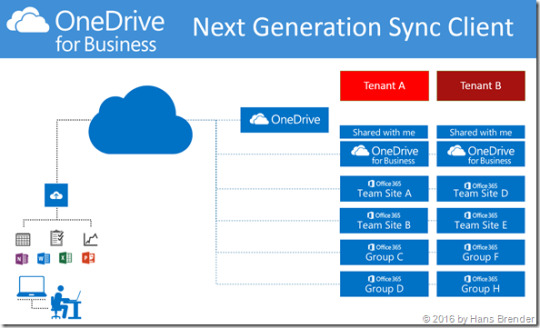
This is a file that I deleted from OneDrive. You can recover the file from here.
Teams Onedrive Sync
I hope this helps to give you a better Teams experience. For more tips on maximizing productivity and connectivity with Teams, check out this blog post about integration with Smartsheet.

0 notes
Text
Office 365: Deployment scenarios and tips and tricks for the introduction
Companies that use Microsoft products come across Office 365 at the latest when renewing their licenses. But who is Office 365 interesting for? What should be considered when introducing it? And what are the deployment scenarios?
After taking office at Microsoft in February 2014, Satya Nadella turned the company around and proclaimed a "cloud-first" strategy. nterprises feel this at the latest when their Microsoft license consultant comes to the company to renew and adjust licenses.
Initially, the Office 365 tariffs were still relatively clear. For example, the Office 365 Enterprise E3 plan initially more or less combined the basic services Exchange Online, SharePoint Online, OneDrive for Business, Skype for Business Online and Office 365 ProPlus. In the course of time, not only were further Office 365 functions such as Groups, Planner and Teams added, but also Azure services such as Microsoft Stream. In addition, with "Enterprise Mobility + Security" (EMS), security functions were combined in a separate, new plan.
Microsoft then combined Office 365, EMS and Windows 10 Enterprise with Secure Productive Enterprise (SPE). The current gem is Microsoft 365, which is essentially a renaming of SPE and an adjustment to the licensing terms to include Office 365, Windows 10 and EMS. For Microsoft customers, this is a complete package at an attractive price - at least if some included features are used.
On the other hand, Microsoft 365 consists of so many functions that projects become significantly more complex. Companies that can't even introduce all the functions at once often ask themselves how to approach an introduction in the first place.
Office 365: Typical scenarios
From practical experience, it can be reported that every Office 365 project is unique. This is due on the one hand to the possibilities of the Office 365 Cloud and on the other hand to the different OnPremise IT infrastructures. Nevertheless, there are typical deployment scenarios for Office 365.
For the undecided: Office 365 ProPlus with OnPremise services.
A scenario that seems unusual at first glance, but is nevertheless encountered in practice, is licensing users with Office 365 licenses and using OnPremise servers for Exchange, SharePoint and Skype for Business. Office 365 ProPlus is activated via a Microsoft nline activation server. Dual access rights allow Office 365 Enterprise User Subscription Licenses (USLs) to be used instead of Client Access Licenses (CALs) for the OnPremise servers. Details can be found in the Office 365 Licensing Factsheet on download.microsoft.com (PDF).
However, licenses must still be purchased for the server software and features included in the cloud, such as anti-spam and anti-virus protection, must be purchased for Exchange. Add-on services such as Office 365 Groups, Planner and Teams are completely left out of this pure licensing construct, leaving many purchased and licensed features "on the street." This scenario is predominantly found in the public sector or in companies that are still unsure about whether and which data may be stored in the cloud due to the issue of data protection.
Quick start: Exchange Online
Of the online services where data actually resides in the cloud - i.e., excluding Office 365 ProPlus - Exchange Online is usually the first service to be introduced. The reason for this is that, on the one hand, the use of e-mail services has already been familiar to everyone from the private world for years and thus the inhibition threshold for the switch is particularly low. On the other hand, many Office 365 functions are based on Exchange Online.
One example is Office 365 Groups, which consist of Exchange Online and SharePoint Online. All functions based on Office 365 Groups, such as Planner and Teams, are also included. The classic start into the Office 365 world is therefore the migration of email mailboxes to Exchange Online.
Store documents centrally and share them easily
After Exchange Online is rolled out, experience shows that OneDrive for Business and SharePoint Online are rolled out to users. OneDrive for Business provides users with their own private file storage that is accessible from all endpoints. In addition, files can be shared with other users inside or outside the organization and edited simultaneously.
Furthermore, OneDrive for Business is integrated with Exchange Online and enables the sending of modern attachments. This means that attachments are no longer attached to e-mails, but remain in the OneDrive for Business storage of the sender and the recipient has read or write access to the attachments in the OneDrive for Business storage of the sender.
Another component of Office 365 workplaces is SharePoint Online. As a central collaboration tool, it can be used, for example, as an intranet, for workflows such as vacation approval, or as a central document repository. A typical use case from practice is its use as a customer or partner portal.
With OneDrive for Business, the user himself decides with which partners external files are shared. Many companies therefore deactivate the external sharing function for their users in OneDrive for Business and provide a portal in SharePoint Online for the external sharing of files.
This not only gives the IT department better control over data exchange with other companies, but also the partner managers responsible within the company. Furthermore, customization is possible, such as tracking document retrievals or expiration of data access after a certain number of days.
Skype for Business Online: Networking colleagues better
While the use of e-mail seems rather formal, the chat function of Skype for Business allows you to get in touch with others faster, more directly and, above all, more personally. In addition to instant messaging, Skype for Business Online's standard features include desktop and program sharing, as well as audio and video conferencing. Skype for Business is based on Outlook and Exchange. Meetings can thus be created and sent directly in Outlook, and chat histories are stored in the Exchange e-mail inbox.
Skype for Business Online is mostly found with other Office 365 services. Less common, but also possible, is Skype for Business Online as a stand-alone Office 365 service in combination with OnPremise Exchange. Skype for Business Online is also often used in parallel with existing telephony solutions to supplement the existing telephony infrastructure with instant messaging and online meetings.
If users want to "Skype" properly - i.e., conduct audio and video conferences - each user needs a headset and a video camera. Phone calls to landlines are also possible. For this purpose, on-premise Skype for Business servers can be connected to the telephone system, for example in the form of the Skype for Business Cloud Connector.
Since November 1, 2017, Microsoft has also been offering external telephony in Germany directly from the cloud. External telephony from the cloud can be purchased with an Office 365 calling plan. With the help of Skype for Business Online, especially in the high-end expansion stage, working and telephoning from anywhere becomes possible and is a must for a modern workplace.
The scenarios described relate primarily to the basic services Exchange Online, SharePoint Online, OneDrive for Business, Skype for Business Online and Office 365 ProPlus. Office 365 also offers other additional services such as Office 365 Groups and the Teams communication platform.
These added values build on the basic services. Microsoft Teams in particular is currently the talk of the town, as it basically combines all Office 365 basic services in a single interface. In addition, Microsoft announced at Ignite, the group's technical conference, last September that Skype for Business would be integrated into Teams.
However, many of the Office 365 value-adds should be taken with a grain of salt. For one thing, some of the functionality, such as an integrated export/import option for Planner, is missing, or functionality will be added later. For example, a PowerShell module for Microsoft Teams was not released until Nov. 3, 2017, a year later than Teams itself.
In addition, the additional services are features that are only included in Office 365 and cannot be made available OnPremise. Exit options from the Office 365 cloud are thus significantly limited. All companies therefore see both opportunities in these services, but also risks.
0 notes
Text
Why do SharePoint Governance Best Practices matter?

SharePoint Governance Best Practices play a major role in the smooth and efficient functioning of Advanced Collaboration platforms such SharePoint, M365, Microsoft Teams and more. Good governance can add significant value to your organization by extensively integrating this platform to your centralized business goals. A proper governance strategy connects your business and users to this platform to help, support and secure all your content and collaborative communication. It lets you:
Drive user adoption
Maximize ROI
Reduce risk.
Improve productivity and business agility.
WHY DO SHAREPOINT GOVERNANCE BEST PRACTICES MATTER?
With expert-curated governance plans and guidelines, a governance strategy helps support and secure the content and users of the SharePoint platform.
For instance, SharePoint is so useful and SharePoint sites can be created and deployed so quickly and easily that organizations end up in a cluttered mess. As a result, users can’t find the content they need, and administrators can’t keep track of sensitive content and protect it properly — the platform fails to meet the organization’s goals due to the governance gap. Having strong governance in place avoids these issues, enabling the business to:
• Drive user adoption — Strong governance helps ensure SharePoint content is easy to create, find and use, so users will embrace the platform rather than try to find ways to work around it.
• Maximize ROI — A governance plan helps you uncover the value of the platform and guide its strategic development, so you get the most from your investment.
• Reduce risk — A governance plan that protects business IP and is aligned with appropriate compliance regulations minimizes potentially devastating risk. For instance, a good governance plan will include provisions for regularly running audits on usage, security, content or permissions.
• Improve productivity and business agility — A well-governed SharePoint platform creates a deep pool of collective intelligence across an organization, arming users with the information and context to move faster and make smarter decisions.
PILLARS TO AWESOME SHAREPOINT GOVERNANCE
Four secrets to success More broadly, you need to build trust in your SharePoint governance strategy. Following these four principles can help ensure success.
VISIBILITY
Make the work you do to define policies and procedures a matter of public discourse. One of the more successful governance initiatives I led started with a town hall event, with a Q&A for anyone interested enough to come and raise their hand. Our regular governance body meetings were open-door sessions, with end-users and executives alike joining in when something they had a vested interest in was being discussed.
REGULAR KEY UPDATES
Keep people informed about your progress. Sometimes updating a SharePoint task list at the end of the day is sufficient; sometimes more frequent communication using other tools is the right choice. Vary this collaboration level depending upon the immediacy of the workload in front of you and the maturity of your governance plan over time.
CONSTANT OPTIMIZATION
Don’t roll out a governance plan, document it in a binder, and put that binder on a shelf to gather dust and be forgotten. Project activities, reporting, and communication strategies constantly evolve because of changing business requirements, customer needs, and other factors. Keep upgrading your governance strategy for the better.
GATHER FEEDBACK, ACT ON IT
This tip was mentioned earlier but it bears repeating: Seek out feedback from your users and pay attention to it. Some people have no problem speaking up, but other people might not be so forthcoming. Look for opportunities to reach out and connect so that you can get a more complete view of what people think. When people are heard, it builds confidence in your strategy.
BEST PRACTICES FOR BUILDING A SHAREPOINT GOVERNANCE STRATEGY
Developing and maintaining a strong SharePoint governance strategy requires careful planning upfront and continual nurturing and adjustments as you use the platform. The following best practices will help you throughout the process.
CREATE AN INTERNAL SHAREPOINT USER GROUP
In an ideal world, organizations will build a SharePoint governance plan before implementing the platform. If you’re proactively building a governance plan, the first step is to talk with your future users so you can understand their content, workflows and anticipated usage. However, as noted earlier, SharePoint is so useful and easy to deploy that often sites go up first and governance comes later. In that case, the first step is still the same — talk with your users! Find out how they are interacting with SharePoint, including what sites are out there, how much they are used, who has access to them, what types of content are being stored there, and what frustrations users have.
BUILD A BROADER COMMUNICATION STRATEGY
Don’t limit your communications to the SharePoint user group; you also need to keep the larger SharePoint community abreast of what is happening with the platform, including details on the governance strategy, changes to policies, site redesigns or a platform upgrade. Make sure to solicit their feedback using strategies like community sites and polls, along with data such as search metrics — and consider their ideas seriously. Governance should enable them not to prevent them from being productive. Look for ways to ensure user adoption of the platform, such as offering training and support.
PROMOTE GOVERNANCE TRANSPARENCY
Make your policies visible. When people ask questions, point them to a SharePoint site with the answers. Make the site functional and refresh it frequently; it should not be a one-time dumping ground for rarely used process documentation. This should be a working platform from which you manage your process, accept suggestions and make changes as needed.
CLEARLY DEFINE ROLES AND RESPONSIBILITIES.
Outline the functions required to deploy and govern your SharePoint environment at the enterprise, organizational and site levels. Define roles according to skills and interests. Define Owner, Approver, Reviewer, and Participant for each of these tasks. It is simple and clear. Determine which functions should be managed centrally and which are better handled at the site collection and site levels. SharePoint works best when the management of its many functions is distributed to the people who know how the business should be run. Be clear on w clear on what you expect from each role so people can be held accountable.
DON’T START FROM SCRATCH, TAILOR IT TO MEET YOUR BUSINESS NEEDS
Microsoft provides plenty of content around optimal settings and system limitations, and that’s a good place to start. But having a personalized strategy involving selected SharePoint Governance Best Practices always help. Just need to remember that you need to constantly refine your strategy based on a solid understanding of your own business requirements. Adapt your policies (content limits, permissions, information rights management policies, and so on) using a consistent and transparent change management process to fit into the organizational priorities.
STANDARDIZE YOUR POLICIES AND PROCEDURES.
Create policies and procedures that are consistent across your organization. A given business unit might have different information rights management rules than the rest of the company, but the policies that govern how those rules are managed should be consistent across the organization.
WHEN YOU NEED TO MIGRATE CONTENT, LEVERAGE YOUR METADATA
Resist the urge to complete migrations as quickly as possible by simply dumping all data from the source environment into the target. Instead, use your metadata to sort your content by relevance, age, popularity, team, geography and other factors. By reducing the amount of sprawl and improving organization, you will deliver a target environment that’s easier for you to manage and easier for users to navigate, reducing overhead while improving user productivity and driving platform adoption.
GOVERNANCE AND CULTURE
Organizational culture plays a major role in governance planning as well as implementation. Define the rules applied to SharePoint management that is valid for everyone in the company with maybe different permission levels. For example, some people might believe that it is better for users to create their own sites on SharePoint while some might consider such vast and unrestricted access to SharePoint to be a major risk factor. There are many other areas in SharePoint related to the use of data, where it is stored, and who has access to that data and all you must do is, follow the basic SharePoint governance best practices and plan judiciously according to your organizational needs.
Saketa SharePoint Governance Center
Your Favourite SharePoint Migrator Now Comes with A Dedicated Governance Module.
Make your SharePoint Migration and Office 365 migration effortless while taking care of the Governance part as well.
7 DAYS FREE TRIAL
0 notes
Text
Manage Office 365 User Accounts via Office 365 Support
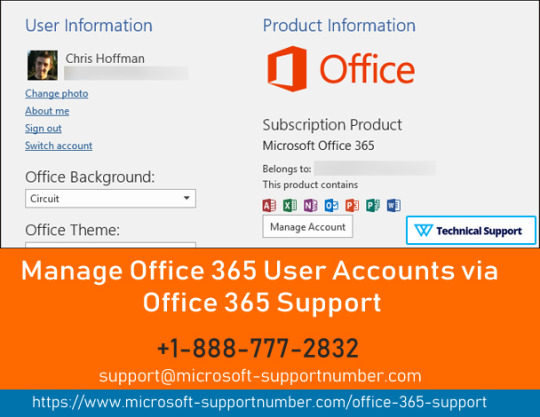
Office 365 is fast turning out to be a single unified platform for productivity, communication and association for the enterprise. Managing your Office 365 enterprise requires a completely different set of resources and tools from the ones used to manage your enterprise on premises. This article will give you the insights on 'What' and 'How' of managing your Office 365 environment. The key feature for moving to Office 365 environment is to reduce the cost and utilize every Information Technology resources in a much better way to enhance your business efficiency in a collaborative environment. Take Office 365 Support at the comfort from your home for relevant ideas related to this managing software kind of problem.
Much effort has been put into the management interface for Office 365. It’s basically designed with the regular user in mind, so managing the service doesn’t need to have technical knowledge. Being aware of these options will assist you in selecting the best path for organizing the functionality of your business; from migrating to Office 365, to getting the very best out of the product.
Methods to Manage Office 365 User Accounts
Go through the below-noted instruction step-by-step to hassle-freely manage Office 365 users’ account. Have a glimpse here:
1. Setup
1. Overview Page: Use this to find information on setting up your Office 365 world. Here, you'll get a good overview on configuration settings.
2. Custom Plan Wizard: Guides you step-by-step through adopting and migrating to Office 365.
2. Management
1. Users: If you're using local Active Directory synchronisation, accounts should be deleted from the local Active Directory not Office 365.
2. Security: This can be configured in SharePoint Online to control access to sites.
3. Domains: Use your company’s domain name in your Office 365 account.
3. Subscriptions: Take care of the subscriptions and billing for your Office 365 rollout.
Still Not Enough Understand?
Here is an extra tip you need to focus on and perform the same as it is on your own. So, if you get stuck and facing any problem while managing your Office 365 account, make freely connection with Microsoft 365 Support team and share all your hurdles without any hesitation. The techies will let you inform the whole managing process.
View Source- https://office-365-help.blogspot.com/2019/06/manage-office-365-user-accounts.html
0 notes
Text
How SharePoint Migrate Users from One Domain to Another
Organizations use Microsoft SharePoint for monitoring projects and improved collaboration among employees. SharePoint is a private network that stores all information and profiles of all employees in the departments. When companies decide to take down their intranet because it no longer serves them or for whatever reason, they want to make sure that all user profiles are retained. This why they migrate user profiles from one SharePoint domain to another.

There are things you need to consider before you migrate SharePoint users to new domain. There are different ways of migrating users in Microsoft SharePoint, and we’ll discuss more of that in this blog.
Take note that this blog will only talk about the Move-SPUser cmdlet that applies only to SharePoint Servers 2010, 2013, 2016, and 2019. A cmdlet is a command used in the Windows PowerShell environment. The Move-SPUser cmdlet allows for migration of user access from one domain user account to another.
Here’s an example of migrating a user profile from domain A to the new account of the said profile in domain B with security identified (SID) history enabled. Every time an object is transferred or migrated from one domain to another, a new SID is created and becomes the objectSID. The example below is for a user named Anne Smith.
$user = Get-SPUser -Identity "DomainA\AnneSmith" -Web https://webUrl
Move-SPUser -Identity $user -NewAlias "DomainB\AnneSmith"
You can also migrate a user from domain A to the new account in domain B. Below is a sample script of how you do this migration from DOMAIN\AnneSmith to Domain\AnneMiller. This example is helpful to user profiles who changed their last name.
$user = Get-SPUser -Identity "DOMAIN\AnneSmith" -Web https://webUrl
Move-SPUser -Identity $user -NewAlias "Domain\AnneMiller" -IgnoreSid
You can also transfer a user account from old domain to the new account in another domain using the Windows Claims. Just remember that -IgnoreSid should be used with Move-SPUser when using a Claims Identity like Windows Claims.
$user = Get-SPUser -Identity "i:0#.w|DOMAIN\AnneSmith" -Web https://webUrl
Move-SPUser -Identity $user -NewAlias "i:0#.w|Domain\AnneMiller" -IgnoreSid
Remember that you must have a valid site where the user account resides in the UIL if you want to use the Move-SPUser.
You can also use the SharePoint Team Server Administration (STSADM) for user migration if you’re using the SharePoint 2007. Please see below for the code.
stsadm -o migrateuser -oldlogin 'i:0#.w|lab\jdoe' -newlogin 'i:0#.w|xenonatom\jdoe' -ignoresidhistory
You can also migrate active directory groups in Microsoft SharePoint from old to new domain using PowerShell. Here’s a sample script.
#Old and New Groups
$OldLogin="OldDomain\Group"
$NewLogin="NewDomain\Group"
#Migrate AD Group
$Farm = Get-SPFarm
$Farm.MigrateGroup($OldLogin, $NewLogin)
Tips Before Migrating Users
Determine the individual or group profiles to be carried to the new domain. There are instances when user or group profiles will not be used in the new domain because these accounts may no longer be working in the company or a certain department or division has been dissolved.

There are also users who temporarily use accounts because they are only working for a company as contractual. If a project-based employee leaves, his or her user profile must also be taken down. So, before migrating user profiles, the accounts must be checked and verified by the company.
You also need to assess how many user profiles must be carried to the new domain because migrating user accounts can take up space. This is why verifying the active accounts to be transferred to a new domain is crucial.
Another important thing to consider before SharePoint migrate users from one domain to another is you have to check if there are duplications to user profiles. Names of employees or users may have similar first names and last names. Updated user profile information like contact number, email addresses, job title, department, and the like must also be validated to avoid hassle in the future.
User profile permissions must also be considered and be recorded before you migrate SharePoint users to new domain. Permissions of user profiles in the old domain are not carried in the new domain. If you have a record of the user permissions, that would be beneficial.

There you have it. We hope we helped you with at least the first few steps on how to migrate SharePoint users to new domain. Have you tried migrating user profiles from one domain to another? How has it worked for you and what tools did you use?
Let us know in the comment section if you have other ways in migrating user profiles across different domains. We’d love to know your experience. Don’t forget to share this blog on your social media accounts.
#sharepoint migrate users from one domain to another#migrate sharepoint users to new domain#microsoft sharepoint
0 notes
Text
Microsoft Office 365 Administration Inside Out (Includes Current Book Service), 2/e - Ed Fisher, Lou Mandich, Darryl Kegg, Aaron Guilmette & Tim Farmer
Microsoft Office 365 Administration Inside Out (Includes Current Book Service), 2/e
Ed Fisher, Lou Mandich, Darryl Kegg, Aaron Guilmette & Tim Farmer
Genre: Computers
Price: $47.99
Publish Date: November 23, 2017
Publisher: Pearson Education
Seller: Pearson Education Inc.
Conquer Microsoft Office 365 Administration–from the inside out! Dive into Microsoft Office 365 Administration–and really put your Office 365 expertise to work. This supremely organized reference packs hundreds of timesaving solutions, tips, and workarounds–all you need to plan, implement, and operate Microsoft Office 365 in any environment. In this completely revamped Second Edition, a new author team thoroughly reviews the administration tools and capabilities available in the latest versions of Microsoft Office 365, and also adds extensive new coverage of Azure cloud services and SharePoint. Discover how experts tackle today’s essential tasks–and challenge yourself to new levels of mastery. Install, customize, and use Office 365’s portal, dashboard, and admin centers Make optimal decisions about tenancy, licensing, infrastructure, and hybrid options Prepare your environment for the cloud Manage Office 365 identity and access via federation services, password and directory synchronization, authentication, and AAD Connect Implement alerts and threat management in the Security & Compliance Center Establish Office 365 data classifications, loss prevention plans, and governance Prepare your on-premises environment to connect with Exchange Online Manage resource types, billing and licensing, service health reporting, and support Move mailboxes to Exchange Online via cutover, staged, and express migrations Establish hybrid environments with the Office 365 Hybrid Configuration Wizard Administer Exchange Online, from recipients and transport to malware filtering Understand, plan, and deploy Skype for Business Online Current Book Service In addition, this book is part of the Current Book Service from Microsoft Press. Books in this program receive periodic updates to address significant software changes for 12 to 18 months following the original publication date via a free Web Edition. Learn more at https://www.microsoftpressstore.com/cbs. http://dlvr.it/R0ncMK
0 notes
Text
SharePoint Roadmap Pitstop: January 2019
The SharePoint team has been hard at work with great new updates rolled out in January 2019. This is the comprehensive recap for all things SharePoint and related technology, plus the Intrazone Roadmap Pitstop: January 2019 episode – a bonus monthly audible companion to help answ...
"SharePoint Roadmap Pitstop: January 2019" by Mark Kashman originally published January 31st 2019 in Microsoft SharePoint Blog articles
The SharePoint team has been hard at work with great new updates rolled out in January 2019. This is the comprehensive recap for all things SharePoint and related technology, plus the Intrazone Roadmap Pitstop: January 2019 episode – a bonus monthly audible companion to help answer, "What's rolling out now for SharePoint and related technologies into Office 365?" It's all about supporting good change management based on feedback from you, our listeners/readers - so thank you.
Listen and scroll below (info, links and screenshots) to stay informed on how the SharePoint team kicks off 2019 - plus a few teasers of what's to come:
In this podcast episode, I, too, talk with Tejas Mehta (LinkedIn | Twitter), principal program manager on the SharePoint engineering team who focuses on all things SharePoint + Microsoft Teams integrations – better together (thanks to Tejas).
All the features listed below began rolling out to Targeted Release customers in Office 365 as of January 2019 (possibly early February 2019). “Buckle up! 2019 is gonna be a rip-roaring roadmap ride!" – Me. 😉
Inform and engage with dynamic employee experiences
Events web part now rolls up event items from numerous source sites
Can be configured to show content from various source sites – with choices ranging from “This site” to “Select sites” and “All sites in the hub” etc. This update enables you to choose where the event items come from (one site or many) and how they are to be displayed (Filmstrip or Compact). You can additionally refine how they appear by either entering a category name to filter by and/or selecting a date range – as simple as “All upcoming events” to “Next two weeks” to “Select date range” (where you choose the exact range).
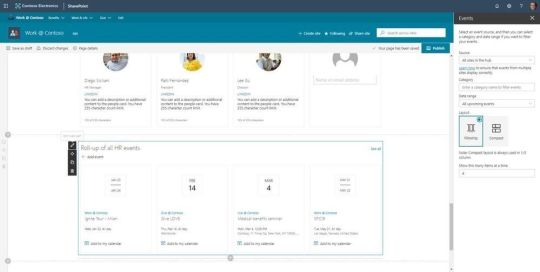
The SharePoint Events web part can now roll up event items from across numerous sites, and better control how they appear on the page. Note the teal hyperlinks text showing the site each event is aggregated from.
Roadmap ID: 33135; learn more.
Learn more about using web parts on SharePoint pages in Office 365.
Learn more about building your modern intranet on SharePoint in Office 365.
Microsoft Stream mobile app is now available for Android & iOS
This is a great mobile app to watch your org and team videos on the go - and even take them offline with you when you're traveling. Get started with the Stream mobile apps for iOS & Android by visiting the App Store and Google Play.
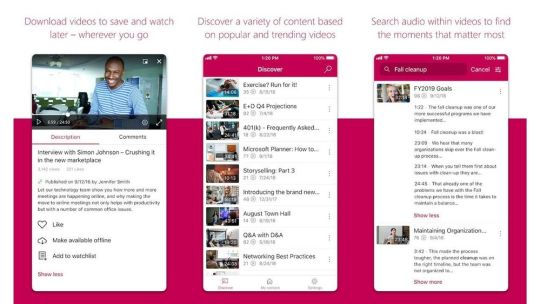
The Microsoft Stream mobile app allows you to find and engage with videos, watch videos offline, and share.
Roadmap ID: 26268; learn more.
Office 365 group-connected team site logo themes appear correct in SharePoint home and SharePoint mobile app
You’ve been asking for this to get updated. This is a color fix for Office 365 group-connected team site logos, and how they are then consistently represented beyond the site itself. When going to change the look and picking a new color for a group with an un-customized logo, the logo color will (NOW PROPERLY) first update on the next page refresh or visit. And then, here comes the real magic of the fix -- it is THE same, consistent color selection that shows in SharePoint home in Office 365 and the SharePoint mobile app; that's the visual coherence people have been asking for.

Office 365 group-connected team site logo themes (left) appear correct in SharePoint home and in SharePoint mobile app (right).
Teamwork updates across SharePoint team sites, OneDrive and Yammer
Mac Files On-Demand (FoD) becoming generally available (GA) (aka, the OneDrive sync client for Mac)
First off, Mac Files On-Demand (FoD) works the same way it does on the PC. Now, what is it? This helps you access all your files in OneDrive without having to download all of them and use storage space on your device. And by ALL files, we mean files from your personal library in OneDrive as well as shared libraries in SharePoint in Office 365. New files created online or on another device appear as online-only files, which don’t take up space on your device. The feature will be on by default for new users on macOS Mojave. This feature will be ramped on for existing users over the coming months. Admins continue to have the ability to disable or enable this feature via a preference.

The new OneDrive sync client lets you sync files from your OneDrive for Business and even from SharePoint sites to your Mac desktop/Finder.
Roadmap ID: 44736; learn more here and here.
No longer be possible to restrict an entire organization (tenant) to classic mode
Starting April 1, 2019, it will no longer be possible to restrict an entire organization (tenant) to classic mode for lists and libraries. Lists and libraries may still use classic mode using the granular opt-out switches that we provide at the site collection, site, list, and library levels. Additionally, lists that use certain features and customizations that are not supported by modern will still be automatically switched to classic mode. This lays the foundation for numerous features rolling out next month - of which I tease below "What's coming in February 2019 teasers" section below.
Learn more.
Important, related technology
Office 365 for Mac is available on the Mac App Store
We’re committed to delivering the power and simplicity of Office in an experience designed specifically for Mac, and we continue to make significant investments in the platform. We’re excited to announce that Office 365 is now available on the newly redesigned Mac App Store. With one click, Mac users can download the cloud-connected, always-up-to-date version of the Office suite—including full installs of Word, Excel, PowerPoint, Outlook, OneNote, and OneDrive.

PowerPoint for Mac downloaded from the Mac App Store running a sample presentation on a MacBook Pro laptop.
“We are excited to welcome Microsoft Office 365 to the all-new Mac App Store in macOS Mojave. Apple and Microsoft have worked together to bring great Office productivity to Mac users from the very beginning. Now, with Office 365 on the Mac App Store, it’s easier than ever to get the latest and best version of Office 365 for Mac, iPad, and iPhone.” —Phil Schiller, Apple’s senior vice president of Worldwide Marketing.
Learn more; download Office 365 from the Mac App Store.
Out of box Flow templates in OneDrive
Easily create and run out-of-box Flow templates directly from OneDrive. Just select a document and click on the Flow button in the command bar. You’ll automatically have the options for the Copy as a PDF and Request sign-off Flow templates. Run the Flow, and with one click, you can create a copy of any document for a PDF or send off an approval.
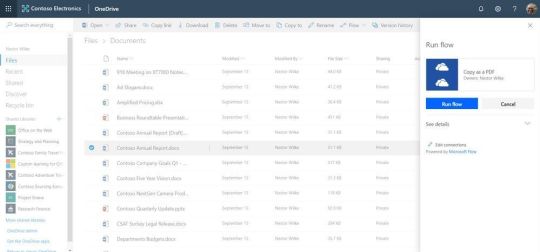
Microsoft Flow Integration in OneDrive running a "Copy as PDF" flow on a Word document.
Roadmap ID: 45703; learn more.
SharePoint Migration tool updates
Designed to be used for migrations ranging from the smallest set of files to a large-scale enterprise migration, the SharePoint Migration Tool will let you bring your information to Office 365. This update brings an improved user interface with a new, simplified control service aligned to the visual themes of SharePoint in Office 365. It, too, gives you the ability to start new migrations without having to restart the SharePoint Migration Tool. Finally, you can more easily access and view the settings needed to support your migration scenario with a new simplified interaction flow and review experience.
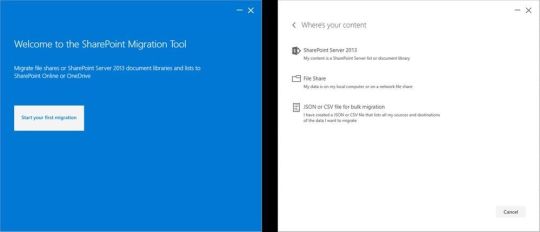
A new, updated SharePoint Migration Tool user interface (UI) aligned with the Office 365 user experience.
Learn more.
Start migrating today using the SharePoint Migration Tool.
Updated Office 365 suite header experience for OneDrive and SharePoint
If a user or company has not customized the Office 365 suite header, they will see that the default app color has changed to be “communication blue.” This is important to communicate to customers who have not branded their header. This update also brings a new help experience – a panel that has a search box, a tip at the top, featured topics in the middle and additional tips. And the SharePoint site settings drop-down is now a right-hand panel. These new experiences just started rolling out to Targeted Release customers.

We’ve aligned on a new Fluent design across the Office apps including a coherent product header and navigation, simplified font styles, warmer color palette, thoughtful elevation system and more.
Roadmap ID 23754; learn more
New icons (including the new teal SharePoint icon) are coming to the Office 365 app launcher
The existing functionality with the Office 365 app launcher and Office.com will remain the same. The only difference will be the icons for Outlook, OneDrive, Word, Excel, PowerPoint, OneNote, SharePoint, Teams, Yammer and Skype will get updated to their new redesigned icons.

The new teal SharePoint icon.
Roadmap ID: 45441; learn more about the new Office icons.
Yammer Adoption Resources has a new look and updated content
Take your network to the next level with helpful adoption resources. Plan your strategy, prepare for launch, communicate a launch moment, training members, ongoing engagement, and ultimately measure success – these are all the resources available to you as your company grows and expands the business, with everyone connected and working together.
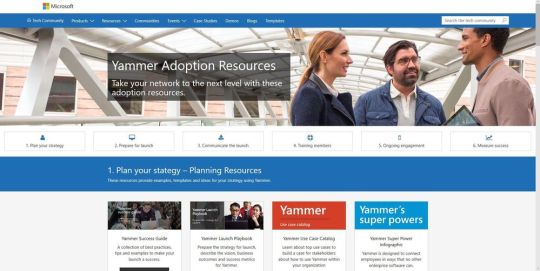
The home page of the updated Yammer Adoption Resources website.
Learn more.
What's coming in February 2019 teasers
Thing 1 - SharePoint lists & libraries get more modern features:
Column totals – You’ll be able to display column totals and subtotals in the footer of a group or a list/library view. [Roadmap ID: 46102]
Sticky headers – For large lists and libraries, the column headers will remain visible as you scroll vertically or horizontally in larger lists and libraries. [Roadmap ID: 46103]
Add columns between columns – You can insert new columns in-place between existing columns in a modern list or library view. [Roadmap ID: 46104]
Column drag and drop – If you need to move a column around in a list or library, just drag the column header to a new location in the view. [Roadmap ID: 46105]
Learn more about all and more.
Thing 2: Microsoft Stream can have quizzes & polls within the video playback – this is due to integration with Microsoft Forms to seamlessly add quizzes, forms or polling into training videos. Make your videos more engaging and interactive for learners, while giving trainers a way to understand how well the information is being comprehended.
Roadmap ID: 34240; learn more.
Helpful, ongoing change management resources
"Stay on top of Office 365 changes"
"Message center in Office 365"
Install the Office 365 admin app; view Message Center posts and stay current with push notifications.
Microsoft 365 public roadmap + pre-filtered URL for SharePoint, OneDrive, Yammer and Stream roadmap items.
SharePoint community blog
SharePoint twitter handle: @SharePoint
Follow me to catch news and interesting SharePoint things: @mkashman; pre-warning of occasional bad puns, too.
Thanks for tuning in and/or reading this episode/blog of the Intrazone Roadmap Pitstop – January 2019 (blog/podcast). We’re open to your feedback in comments below to hear how both the Roadmap Pitstop podcast episodes and blogs can be improved over time.
We had a lot to share and more to come next year - happiest of new years to you and yours. Please stay engaged. Ask questions. Push us where you want and need to get the best information and insights. We're here to put both our and your best change management foot forward.
Stay safe out there on the roadmap -- and thanks for listening and reading.
Happy now and future trails,
Mark
Read Full Post
0 notes
Text
TIPS HOW TO SEAMLESSLY MIGRATE TO SHAREPOINT ONLINE
On the off chance that you're intending to come up with unwelcome surprises as you migrate to Sharepoint Online, then don’t read these useful tips! On the other hand consider these tips if you want to seamlessly or effortlessly and rapidly relocate to Sharepoint Online, arranging your methodology should start a long time before you dispatch this task. Remember likewise this is continuous process and will proceed long after you move your information over to Sharepoint Online. Post movement plan ought to likewise be incorporated in light of the fact that it doesn't end in exchanging the last report; rather it is quite a while duty of checking and modification of conceivable changes that are required.
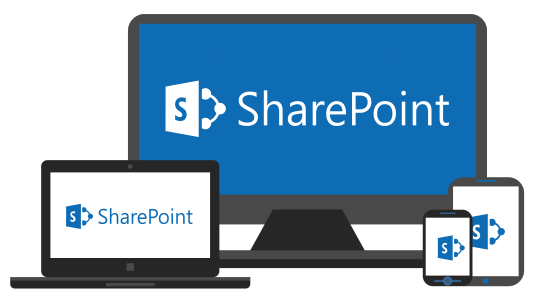
Right off the bat, get ready to move Sharepoint Online by getting full picture of your organization's pieces of information and afterward choose which are should have been relocated. Keep in mind that these reports and informations resemble blood and air to your Portfolio Management System that is the reason each datum sources must be distinguished and mapped to stay away from danger of losing profitable archives. Be extremely watchful in mapping old metadata fields to the new metadata fields. Carefully plan how old facts will be mapped into the new Sharepoint Online. You ought to characterize the goal arrangement, metadata and approaches in Sharepoint. Amid the recognizable proof process you have to consider if every one of the reports are important to relocate to Sharepoint Online or you simply need to move the most recent renditions of every archive.
You have to see obviously what sort of pieces of information you are moving, such us programming contents, database documents, extensive compress records, colossal bitmaps and recordings. You have to distinguish also undermined documents or where information might be unclean or missing and deliberately characterize a way to deal with location these. Be that as it may, before moving to Sharepoint Online, you likewise need to choose heretofore in the event that you have to revamp and rebuild proposals reports or records. Ensure that the new structure is better and increasingly powerful. Plan likewise which recovery design that you will use for every specific archives. Comprehend the structure of the source framework from which you are moving
All together for your Sharepoint Online to dispatch on time and be on live with vital substance, your group ought to have appropriately figured the time allotment required in the real movement. This might be conceivable in the event that you appropriately mapped your organization's information and effectively distinguished the aggregate number of archives that you have to relocate to Sharepoint Online.
You can complete a brisk test on to what extent a solitary archive can be moved after this straightforward equation: the summation of the time it take to trade a report from your old framework and time it takes to transfer a record to Sharepoint Online, at that point duplicate the outcome to the quantity of aggregate archives that you have to move to Sharepoint Online. Assess additionally the vital required segments, for example, equipment, programming, plate space and other inward assets. Try not to neglect as well the potential dangers that you may experience amid the relocation procedure with the goal that you will have the prepared crisis conventions and back up plans. Be sure to double check that your Sharepoint Online sites and content meet all your PPM's standard requirements
0 notes